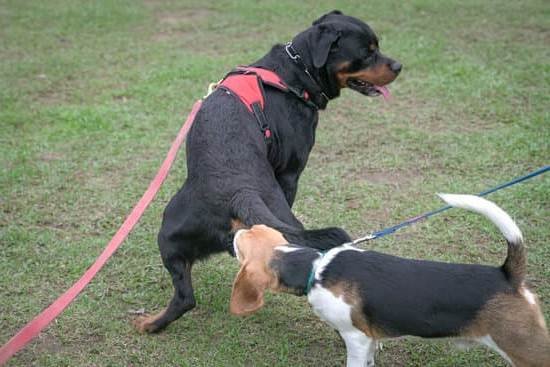Are you wondering how to train your dog not to bark when you leave? Excessive barking can be a challenging behavior to address, but with patience and the right training techniques, it is possible to reduce or eliminate this behavior.
Understanding the underlying reasons for excessive barking is crucial in developing an effective training plan. This article will provide practical tips and strategies to help you train your dog not to bark when you leave, creating a more peaceful environment for both you and your furry friend.
One of the first steps in addressing excessive barking is understanding why your dog may be exhibiting this behavior. Factors such as separation anxiety, boredom, territorial instincts, or fear can contribute to excessive barking when left alone. By identifying the root cause of your dog’s barking, you can tailor your training approach to effectively address these underlying issues.
Creating a designated safe space for your dog when you leave is essential in helping them feel secure and comfortable during your absence. This space should be equipped with all the necessary essentials such as water, bedding, and interactive toys to keep them occupied.
Establishing a routine and consistency in your departures can also help reduce anxiety and uncertainty for your dog. These are just some of the strategies that we will explore in this article to effectively address excessive barking when you leave your home.
Creating a Designated Safe Space for Your Dog When You Leave
One effective way to train your dog not to bark when you leave is by creating a designated safe space for them. This area should be a comfortable and secure place where your dog can feel safe and relaxed in your absence. Here are some tips on how to create this designated safe space for your furry friend:
- Choose a quiet and less-trafficked area in your home where your dog can have some peace and quiet. This could be a corner of the living room or a specific room in the house.
- Set up a cozy bed or blanket, as well as some of your dog’s favorite toys or comforting items in their safe space.
- Consider using pheromone diffusers or calming scents in the area to help relax your dog when you’re not around.
By creating a designated safe space for your dog, you can help them feel more secure and less anxious when you leave the house. This can contribute to reducing their tendency to bark excessively when you’re not home.
It’s important to remember that every dog is different, so it may take some trial and error to find the perfect safe space for your furry friend. Be patient and observant of their behavior to determine what environment makes them feel most comfortable and at ease when you’re away.
Remember, consistency is key when implementing this training method. Make sure to establish this designated safe space as part of your routine departure process, so your dog knows what to expect each time you leave.
Establishing a Routine and Consistency in Your Departures
Having a consistent routine when leaving your dog can significantly help in training them not to bark excessively. Dogs thrive on predictability, so establishing a set pattern for your departures can help ease their anxiety.
This involves performing the same actions before leaving, such as grabbing your keys, putting on your shoes, and saying a specific phrase, in the same order each time. By doing this, your dog will learn to associate these actions with you leaving and it can help reduce their stress.
In addition to creating a consistent departure routine, it is important to remain calm and composed when leaving the house. Dogs are highly attuned to their owner’s emotions and energy, so if you show signs of stress or worry before leaving, it can cause your dog to become anxious as well. Therefore, remaining calm and unfazed during your departure can convey a sense of normalcy to your dog and help alleviate their separation anxiety.
Another crucial aspect of establishing a routine is maintaining consistency in the length of time you are away. Gradually increasing the duration of your departures can help desensitize your dog to being alone. This process must be done slowly and gradually over time to prevent overwhelming your dog. By consistently practicing this method, you can train your dog not to bark when you leave through repetition and reassurance.
| Training Method | Key Benefits |
|---|---|
| Establishing a consistent departure routine | Helps ease anxiety by providing predictability |
| Maintaining calm demeanor during departure | Conveys a sense of normalcy and reduces stress for the dog |
| Gradually increasing absence duration | Desensitizes the dog to being alone without causing distress |
Using Positive Reinforcement and Reward-Based Training Methods
Positive reinforcement and reward-based training methods are essential in teaching your dog not to bark when you leave. This approach focuses on rewarding your dog for exhibiting calm behavior while you are away, rather than punishing them for barking. By using positive reinforcement, you can effectively communicate to your dog what behavior is desired and encourage them to repeat it.
Identifying the Right Rewards
When using positive reinforcement, it’s important to find the right rewards that will motivate your dog. Whether it’s their favorite treat, a special toy, or verbal praise, find what really gets your dog excited and use that as a reward for good behavior.
Training With Consistency
Consistency is key when using positive reinforcement. Make sure to always reward your dog when they remain calm and quiet after you leave. This will teach them that being quiet leads to a positive outcome, making them more likely to exhibit this behavior in the future.
Ignoring Bad Behavior
In addition to rewarding good behavior, it’s also important to ignore any barking or whining that may occur when you leave. Reacting to their barking by giving them attention or getting frustrated can reinforce this behavior. Instead, wait for a moment of silence before returning and then reward them for being quiet.
Using positive reinforcement and reward-based training methods is an effective way to train your dog not to bark when you leave. By identifying the right rewards, training with consistency, and ignoring bad behavior, you can effectively communicate with your pet and encourage them to exhibit calm behavior even when you’re not at home.
Implementing Desensitization Techniques to Gradually Acclimate Your Dog to Being Alone
Excessive barking when you leave can be a sign of separation anxiety or distress in dogs. This behavior can be disruptive to your household and even cause stress for your pet. Implementing desensitization techniques is an effective way to gradually acclimate your dog to being alone and reduce their tendency to bark excessively when you leave.
Desensitization involves exposing your dog to the trigger of their barking (in this case, your departure) in a controlled and gradual manner. Here are some steps on how to train your dog not to bark when you leave using desensitization techniques:
- Start by practicing brief departures, such as stepping outside the door for a few seconds, then returning. Gradually increase the duration of your absence as your dog becomes more comfortable with the process.
- Use a consistent departure routine so that your dog knows what to expect. This can help reduce anxiety and uncertainty about when you will return.
- Consider leaving interactive toys or puzzles for your dog to engage with while you are gone, providing mental stimulation and distraction from barking.
Remember that each dog is different, so it’s important to monitor their progress and make necessary adjustments to the training plan as needed. Seeking professional help from a certified dog trainer or behaviorist may also be beneficial, especially if your dog’s excessive barking persists despite training efforts at home. With patience, consistency, and positive reinforcement, it is possible to train your dog not to bark excessively when you leave.
Utilizing Interactive Toys and Puzzles to Keep Your Dog Occupied
Dogs are social animals that thrive on mental and physical stimulation. When left alone, some dogs may resort to barking out of boredom or even separation anxiety. Utilizing interactive toys and puzzles can help keep your dog occupied and mentally engaged, thus reducing the likelihood of excessive barking when you leave.
Choosing the Right Interactive Toys and Puzzles
When selecting toys for your dog, consider interactive options that will require mental effort and provide a challenge. Look for toys that dispense treats or food when manipulated, as this will keep your dog focused and entertained. Puzzle toys that require problem-solving skills or ones that can be filled with treats are great options to keep your dog busy.
Introducing the Toys and Puzzles
Once you have selected the appropriate toys and puzzles for your dog, it’s important to introduce them gradually. Show your dog how the toy works and encourage them to interact with it by offering treats or praise as they engage with the toy. This positive reinforcement will create a positive association with the interactive toys and encourage your dog to use them even when you’re not at home.
Rotating Toys to Prevent Boredom
To prevent your dog from getting bored with their interactive toys and puzzles, consider rotating them regularly. Introducing new toys or hiding treats within the puzzle toys will keep things fresh and exciting for your pet. This variety will ensure that they remain engaged in play while you’re away, minimizing the urge to bark due to boredom or anxiety.
By incorporating these interactive toys and puzzles into your dog’s daily routine, you can help alleviate their boredom and keep them mentally stimulated in your absence – ultimately reducing excessive barking when you leave.
Seeking Professional Help and Guidance if Necessary
Seeking professional help and guidance can be an important step in training your dog not to bark when you leave. If you have tried various training methods and strategies without success, it may be beneficial to consult with a certified dog trainer or behaviorist. These professionals have the expertise and experience to assess your dog’s behavior, identify any underlying issues, and develop a customized training plan to address excessive barking.
A professional trainer or behaviorist can provide valuable insights into the root causes of your dog’s barking, whether it stems from separation anxiety, fear, boredom, or other triggers. They can also offer personalized advice on how to modify your departure routine, create a safe and comfortable environment for your dog, and implement effective desensitization techniques.
In some cases, seeking professional help may also involve working with a veterinarian to rule out any medical reasons for your dog’s excessive barking. A comprehensive evaluation by a veterinarian can help determine if there are any underlying health issues contributing to your dog’s behavior. By addressing any potential medical concerns in conjunction with behavioral training, you can improve the overall well-being of your pet and work towards reducing their barking when you leave.
Monitoring and Tracking Your Dog’s Progress and Making Necessary Adjustments to the Training Plan
In conclusion, training a dog not to bark when you leave requires patience, consistency, and understanding of your pet’s needs. By addressing the underlying reasons for excessive barking and creating a designated safe space for your dog, you can help alleviate their anxiety and fear of being alone. Establishing a routine and using positive reinforcement techniques can also help in shaping your dog’s behavior positively.
It is important to implement desensitization techniques to gradually acclimate your dog to being alone, while also providing them with interactive toys and puzzles to keep them occupied. Additionally, monitoring and tracking your dog’s progress is crucial in making necessary adjustments to the training plan. Seeking professional help may also be beneficial if your dog’s excessive barking persists despite your efforts.
Overall, with dedication and the right training methods, it is possible to train a dog not to bark when you leave. Remember that every dog is unique, so it’s essential to tailor the training plan according to their specific needs. Keep practicing patience and remain consistent in your approach as you work towards a quieter departure from home for both you and your furry companion.
Frequently Asked Questions
Do Dogs Grow Out of Barking When You Leave?
Some dogs may grow out of excessive barking when left alone, especially if they are properly trained and provided with mental stimulation and exercise. However, some dogs may continue this behavior without proper intervention.
Will a Dog With Separation Anxiety Stop Barking?
A dog with separation anxiety may not stop barking on its own, as this behavior is often a manifestation of their distress at being left alone. It is important to address the root cause of the anxiety and work with a professional to help the dog overcome this issue.
Can Separation Anxiety in Dogs Be Cured?
Separation anxiety in dogs can be managed and improved with proper training, behavior modification, and in some cases, medication. While it may not necessarily be “cured” in the traditional sense, it can be effectively controlled to improve the dog’s well-being and quality of life.

Welcome to the blog! I am a professional dog trainer and have been working with dogs for many years. In this blog, I will be discussing various topics related to dog training, including tips, tricks, and advice. I hope you find this information helpful and informative. Thanks for reading!





